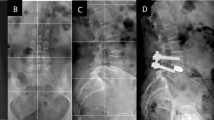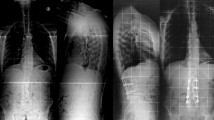Abstract
Introduction
Symptomatic pseudoarthrosis after transforaminal lumbar interbody fusion (TLIF) could result in sagittal malalignment. Revision posterior surgery with TLIF cage removal poses a challenge intraoperatively. The authors have proposed salvage anterior approach for cage removal and have discussed unique experience with the correction in their deformity patients.
Methods
All patients with symptoms of clinical deformity or symptomatic pseudoarthrosis operated from January of 2012 to February of 2018 were included in the study. TLIF cage removal followed by anterior lumbar interbody fusion (ALIF) surgery was performed in all patients. Radiographic sagittal parameters including thoracic kyphosis (TK; T4–T12), sagittal vertical axis (SVA), T1 pelvic angle (TPA), lumbar lordosis (LL), the mismatch between pelvic incidence (PI) and LL (PI-LL), sacral slope (SS), pelvic tilt (PT), and PI were analyzed.
Results
6 patients (mean age of 57 years, 83% female) underwent TLIF retrieval through anterior approach and ALIF with hyperlordotic cages (HLCs), followed by posterior spinal fusion surgery. Described technique entails use of tailored instruments with sequential gentle distraction of end plates with TLIF spreader could facilitate in the cage removal. Mean number of interbody levels fused pre as well as post were 1.5. The radiographic sagittal parameters from preoperative versus postoperative standing were as follows: T4–T12 TK, 16° vs. 37.6°; LL, −25° vs. −47.6°; PT, 36° vs. 26°; PI-LL, 35° vs. 12.4°; SVA, 12° vs. 5.6°; and TPA, 44° vs. 25°, with p<.001. Mean number of instrumented level fused were 8.1. Using linear regression analysis, change from pre-to postoperative standing in LL predicted pre-to postoperative change in SVA and TPA for global correction (R= −0.30 and −0.80, respectively).
Conclusions
Anterior approach is a suitable technique for TLIF cage removal while preserving the end plates for subsequent optimal interbody fusion at the index level in symptomatic pseudoarthrosis patients or those with clinical deformity. ALIF with HLCs with or without Ponte osteotomy can restore segmental and overall sagittal alignment.
Similar content being viewed by others
References
Levin JM, Tanenbaum JE, Steinmetz MP, et al. Posterolateral fusion (PLF) versus transforaminal lumbar interbody fusion (TLIF) for spondylolisthesis: a systematic review and meta-analysis. Spine 72018;18:1088–98.
Salem KMI, Eranki AP, Paquette S, et al. Do intraoperative radiographs predict final lumbar sagittal alignment following single-level transforaminal lumbar interbody fusion? J Neurosurg Spine 2018;28:486–91.
Zaidi HA, Shah A, Kakarla UK. Transdural retrieval of a retropulsed lumbar interbody cage: Technical case report. Asian J Neurosurg 2016;11:71.
Glassman SD, Berven S, Bridwell K, et al. Correlation of radiographic parameters and clinical symptoms in adult scoliosis. Spine (Phila Pa 1976) 2005;30:682–8.
Glassman SD, Bridwell K, Dimar JR, et al. The impact of positive sagittal balance in adult spinal deformity. Spine (Phila Pa 1976) 2005;30:2024–9.
Kim YJ, Bridwell KH, Lenke LG, et al. An analysis of sagittal spinal alignment following long adult lumbar instrumentation and fusion to L5 or S1: can we predict ideal lumbar lordosis? Spine (Phila Pa 1976) 2006;31:2343–52.
Smith JS, Bess S, Shaffrey CI, et al. Dynamic changes of the pelvis and spine are key to predicting postoperative sagittal alignment following pedicle subtraction osteotomy: a critical analysis of preoperative planning techniques. Spine (Phila Pa 1976) 2011;37:845–53.
Schwab FJ, Blondel B, Bess S, et al. International Spine Study Group (ISSG). Radiographical spinopelvic parameters and disability in the setting of adult spinal deformity: a prospective multicenter analysis. Spine (Phila Pa 1976) 2013;38:E803–12.
Potter BK, Freedman BA, Verwiebe EG, et al. Transforaminal lumbar interbody fusion: clinical and radiographic results and complications in 100 consecutive patients. J Spinal Disord Tech 2005;18:337–46.
Seng C, Siddiqui MA, Wong KP, et al. Five-year outcomes of minimally invasive versus open transforaminal lumbar interbody fusion: A matched-pair comparison study. Spine (Phila Pa 1976) 2013;38: 2049–55.
Evans JH. Biomechanics of lumbar fusion. Clin Orthop Relat Res 1985;193:38–46.
Cloward RB. The treatment of ruptured lumbar intervertebral discs by vertebral body fusion. I. Indications, operative technique, after care. J Neurosurg 1953;10:154–68.
Kuslich SD, Ulstrom CL, Griffith SL, et al. The Bagby and Kuslich method of lumbar interbody fusion. History, techniques, and 2-year follow-up results of a United States prospective, multicenter trial. Spine (Phila Pa 1976) 1998;23:1267–78.
Tsahtsarlis A, Efendy JL, Mannion RJ, Wood MJ. Complications from minimally invasive lumbar interbody fusion: Experience from 100 patients. J Clin Neurosci 2013;20:813–7.
Kimura H, Shikata J, Odate S, et al. Risk factors for cage retropulsion after posterior lumbar interbody fusion: analysis of 1070 cases. Spine (Phila Pa 1976) 2012;37:1164–9.
Chen L, Yang H, Tang T Cage migration in spondylolisthesis treated with posterior lumbar interbody fusion using BAK cages. Spine (Phila Pa 1976) 2005;30:2171–5.
Glassman SD, Johnson JR, Raque G, et al. Management of iatrogenic spinal stenosis complicating placement of a fusion cage. A case report. Spine (Phila Pa 1976) 1996;21:2383–6.
Kostuik JP, Maurais GR, Richardson WJ, Okajima Y Combined single stage anterior and posterior osteotomy for correction of iatrogenic lumbar kyphosis. Spine 1988;13:257–66.
La Grone MO. Loss of lumbar lordosis. A complication of spinal fusion for scoliosis. Orthop Clin North Am 1988;19:383–93.
Schwab F, Patel A, Ungar B, et al. Adult spinal deformity-postoperative standing imbalance: how much can you tolerate? An overview of key parameters in assessing alignment and planning corrective surgery. Spine 2010;35:2224–31.
Eom JS, Jeon I, Kim SW Application of lateral approach for the removal of migrated interbody cage: taphole and fixing technique. Korean J Spine 2017;14:23–6.
Moisi M, Page J, Paulson D, Oskouian RJ. Technical note–lateral approach to the lumbar spine for the removal of interbody cages. Cur-eus 2015;7:e268.
Malham GM, Ellis NJ, Parker RM, et al. Clinical outcome and fusion rates after the first 30 extreme lateral interbody fusions. Scientific-WorldJournal 2012;2012:246989.
Hsieh PC, Koski TR, O’Shaughnessy BA, et al. Anterior lumbar interbody fusion in comparison with transforaminal lumbar interbody fusion: implications for the restoration of foraminal height, local disc angle, lumbar lordosis, and sagittal balance. J Neurosurg Spine 2007;7:379–86.
Watkins 4th RG, Hanna R, Chang D, et al. Sagittal alignment after lumbar interbody fusion: comparing anterior, lateral, and transforaminal approaches. J Spinal Disord Tech 2014;27:253–6.
Yun DJ, Yu JW, Jeon SH, et al. Salvage anterior lumbar interbody fusion for pseudoarthrosis after posterior or transforaminal lumbar interbody fusion: a review of 10 patients. World Neurosurg 2018;111: e746–55.
Kadam A, Wigner N, Saville P, Arlet V. Overpowering posterior lumbar instrumentation and fusion with hyperlordotic anterior lumbar interbody cages followed by posterior revision: a preliminary feasibility study. J Neurosurg Spine 2017;27:650–60.
Author information
Authors and Affiliations
Corresponding author
Additional information
Author disclosures: MBJ (none), NA (none), VA (reports support from DePuy Synthes Spine and NuVasive Spine, outside the submitted work).
IRB approval: University of Pennsylvania IRB has been approved for the completion of the study.
Rights and permissions
About this article
Cite this article
Janjua, M.B., Ackshota, N. & Arlet, V. Technical Consideration for TLIF Cage Retrieval and Deformity Correction With Anterior Interbody Fusion in Lumbar Revision Surgeries. Spine Deform 7, 633–640 (2019). https://doi.org/10.1016/j.jspd.2018.10.004
Received:
Revised:
Accepted:
Published:
Issue Date:
DOI: https://doi.org/10.1016/j.jspd.2018.10.004




